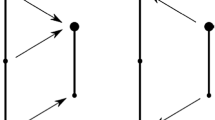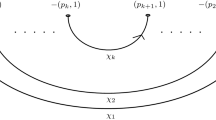Abstract
Trunks are objects loosely analogous to categories. Like a category, a trunk has vertices and edges (analogous to objects and morphisms), but instead of composition (which can be regarded as given by preferred triangles of morphisms) it has preferred squares of edges. A trunk has a natural cubical nerve, analogous to the simplicial nerve of a category. The classifying space of the trunk is the realisation of this nerve. Trunks are important in the theory of racks [8]. A rackX gives rise to a trunkT (X) which has a single vertex and the setX as set of edges. Therack space BX ofX is the realisation of the nerveNT (X) ofT(X). The connection between the nerve of a trunk and the usual (cubical) nerve of a category determines in particular a natural mapBX ↦BAs(X) whereBAs(X) is the classifying space of the associated group ofX. There is an extension to give a classifying space for an augmented rack, which has a natural map to the loop space of the Brown-Higgins classifying space of the associated crossed module [8, Section 2] and [3].
The theory can be used to define invariants of knots and links since any invariant of the rack space of the fundamental rack of a knot or link is ipso facto an invariant of the knot or link.
Similar content being viewed by others
References
Brieskorn, E.: Automorphic sets and singularities,Contemp. Math. 78 (1988), 45–115.
Brown, R. and Higgins, P.: On the algebra of cubes,J. Pure Appl. Algebra 21 (1981), 233–260.
Brown, R. and Higgins, P.: The classifying space of a crossed complex,Math. Proc. Cambridge Philos. Soc. 110 (1991), 95–120.
Brown, R. and Higgins, P.: The classifying space of a crossed complex, U. Coll. of N. Wales, Math. Preprint 89.06, 1989.
Buoncristiano, S., Rourke, C., and Sanderson, B.: A geometric approach to homology theory,London Math. Soc. Lecture Note Ser. 18 (1976).
Conway, J. C. and Wraith, G. C.: Correspondence, 1959.
Duskin, J.: Simplicial methods and the interpretation of “triple” cohomology,Mem. Amer. Math. Soc. 3, Issue 2, (1973), 163.
Fenn, R. and Rourke, C.: Racks and links in codimension two,J. Knot Theory Ramifications 1 (1992), 343–406.
Fenn, R., Rourke, C., and Sanderson, B.: An introduction to species and the rack space, in M. E. Bozhüyük (ed.),Topics in Knot Theory, Kluwer Academic Publishers, 1993, pp. 33–55.
Freyd, P. and Yetter, D.: Braided compact closed categories with applications to low dimensional topology,Adv. Math. 77 (1989), 156–182.
Hintze, H.: Polysets, □-sets and semi-cubical sets, MPhil Thesis, Warwick, 1973.
Joyce, D.: A classifying invariant of Knots; the Knot quandle,J. Pure Appl. Algebra 23 (1982), 37–65.
James, I.: On the suspension triad,Ann. Math. 63 (1956), 191–247.
Kauffman, L.: Knot-crystals — classical Knot theory in modern guise, inKnots and Physics, World Scientific, 1991, pp. 186–204.
Kan, D. M.: Abstract homotopy I,Proc. Nat. Acad. Sci. 41 (1955), 1092–1096.
Matveev, S.: Distributive groupoids in Knot theory,Math. USSR-Sb. 47 (1984), 73–83.
Author information
Authors and Affiliations
Rights and permissions
About this article
Cite this article
Fenn, R., Rourke, C. & Sanderson, B. Trunks and classifying spaces. Appl Categor Struct 3, 321–356 (1995). https://doi.org/10.1007/BF00872903
Received:
Accepted:
Issue Date:
DOI: https://doi.org/10.1007/BF00872903




